Earlier in the year, Lionel Scaloni talked about the impact of Marco Rose in an interview. When the Argentinian head coach, now Copa América winner, visited Rose in Germany, one of the subjects discussed was the use of 4-diamond-2 formation. The former RB Salzburg coach believed the rhombus could walk in South America, and he also had success in Austria from this formation. However, in Germany, this formation was unworkable.
Intriguingly, when Rose left Borussia Monchengladbach to take over Borussia Dortmund this summer, he tried the 4-diamond-2 again. In consecutive matches against Bayern Munich, SC Freiburg, and TSG Hoffenheim, Dortmund stuck to the same shape and got 1W2L, scored five and conceded seven.
What were the reasons for Rose trying the same shape again? This tactical analysis will study some of the offensive setups of their 4-diamond-2.
Build-up phase
In a 4-diamond-2, Dortmund played out from the back with a wide 4-1 shape as Mohamoud Dahoud was the holding midfielder. They always involved the goalkeeper in this phase to move the ball around. Therefore, Gregor Kobel should be perceived as a part of the back three and they had a 3v2 numerical advantage over the two-striker pressing system.

The first image was from Dortmund’s game against Bayern’s 4-4-2 pressing. When the first line pressed the centre-backs, Kobel could pick Dahoud by slicing the ball between the strikers. Then, Dortmund could simply reach the free centre-back and use him to move the ball forward.
When the attack continued, a decisional dilemma was posed on the opposition wingers. Under Julien Nagelsmann, the wingers were more oriented on the centre-backs on the ball side. However, Serge Gnabry was tied with the Nico Schulz on the flank, which was a 1v2. He was late on Manuel Akanji as the wide full-backs in 4-1 shape bought some time for Dortmund at the back.
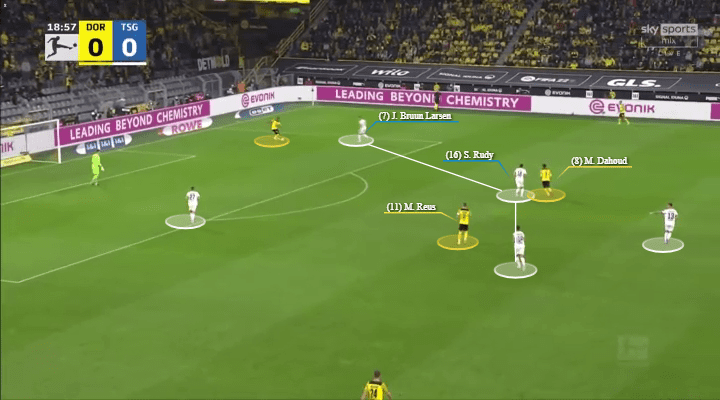
Against teams pressing with a 4-2-3-1 by using wingers to shut centre-backs’ passing lane to full-backs diagonally, the solution was always dropping another player to help. Here, the right-winger of Hoffenheim covered the passing lane to left-back, while the attacking midfielder man-mark Dahoud.
But Dortmund had Marco Reus dropping from a higher position, you could see the defensive midfielder of Hoffenheim, Angelo Stiller (#13) was pulled out of position. Although he eventually asked the left-winger to mark Reus, he was out already.
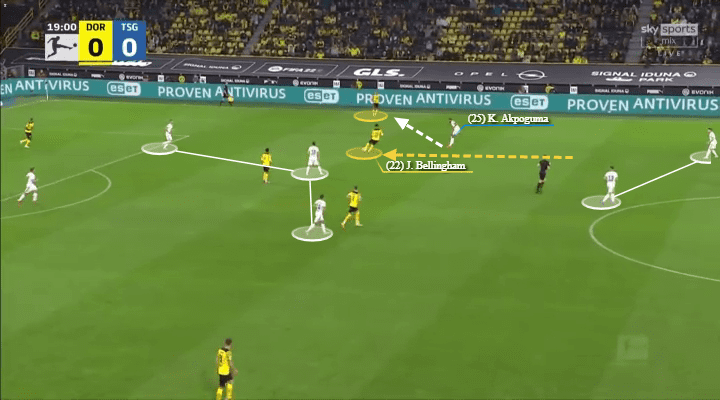
Therefore, Dortmund had big spaces behind the 3-1 pressing as the “2” were stretched. In this case, Jude Bellingham dropped from the left half-spaces to receive a vertical pass from Akanji. As the likes of Dahoud manipulated the man-marker, and Akanji’s initial positioning was deep enough to pull the right-winger away from shape, the passing channel was large.
Then, Dortmund could enjoy their flank overload again. Even Hoffenheim committed the right-back to press high, he was in a 1v2 against the left-back and Bellingham. The Black and Yellow surpassed Kevin Akpoguma with a very simple one-two play.
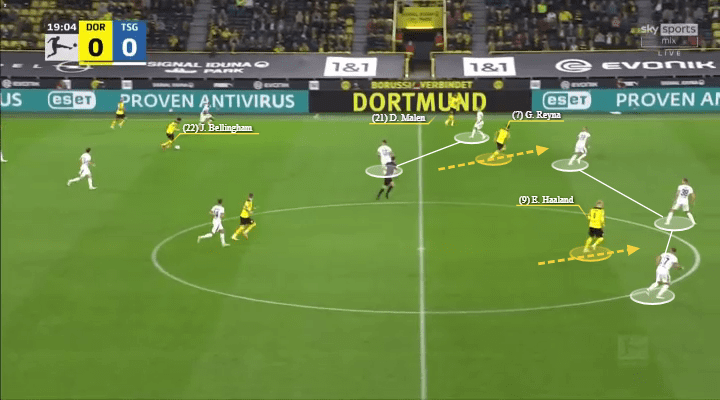
You might wonder why the defensive midfielders were not jumping out to press Bellingham. It was because of Dortmund front players’ positional disciplinary. Their strikers were always very high to push the backline deep, so they stretched the oppositions vertically. Hoffenheim’s defensive midfielders were staying deep to avoid the defence being exposed.
Meanwhile, the players had the freedom to rotate and received in more comfortable positions. We often saw Giovanni Reyna exchanged positions with Reus, so the young American player could move into an advanced position. That would allow Donyell Malen to move on the flanks, where he could use his 1v1 and pace to beat the opponents.
Second phase advantages
But more advantages from Dortmund’s 4-diamond-2 shape were shown in the second phase. We will show more in the following sections.
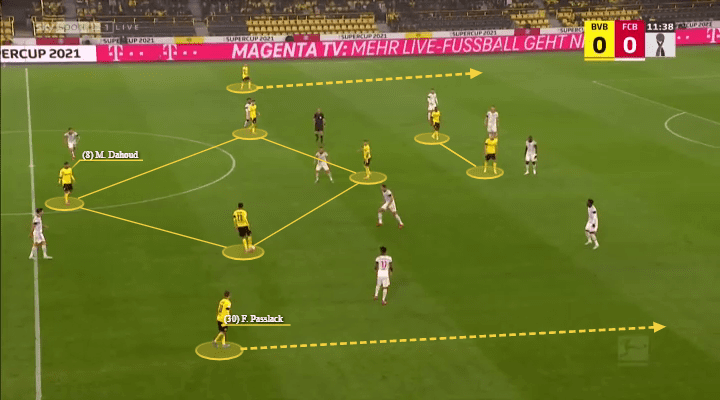
As expected, the diamond could create an overload in the centre, but the team would be lacking the widths. Hence, Dortmund full-backs must stay wide and outside of the formation to compensate. The general shape was on the above screenshot.
A diamond plus two strikers in the attack could allow the team to pick up staggered height positions naturally. In the centre, five layers were easily generated from two centre-backs, a holding midfielder, two wide midfielders, an attacking midfielder, and two strikers. This either imbalance the defensive shape, or the players would be free as Bellingham above.
Another advantage to have eight players in the centre was to draw the opposition narrow, opening the wide spaces to attack.
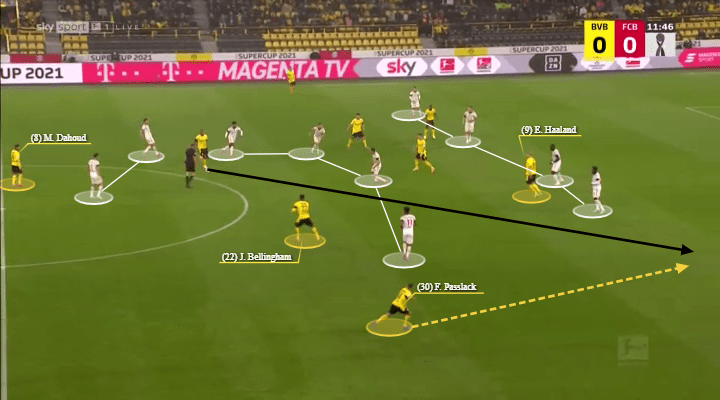
A few seconds after the previous screenshot, Akanji carried the ball forward by capitalizing on the 3v2 advantage with Dahoud. You could see the spaces were easily opened on the outside of the formation.
Here, Bellingham’s half-spaces occupation drew the left-winger inside, while Erling Håland smartly pinned two defenders with his positioning. So, the left-back was narrow, and it was a good chance for the Dortmund right-back to receive behind.
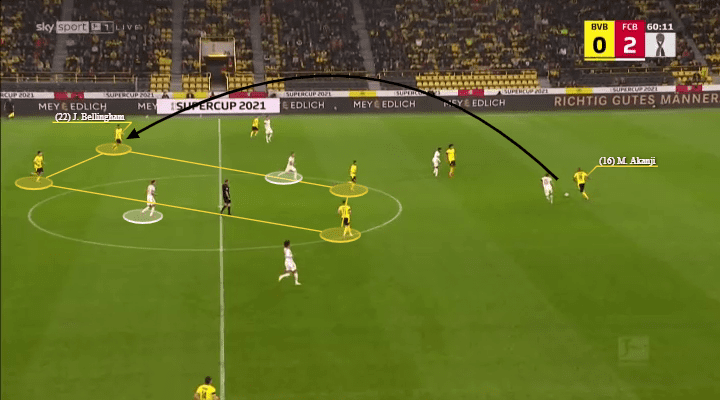
Another example of the usage of 4-diamond-2. Rose paired Axel Witsel and Akanji as centre-back positions in the early days. However, the main source of progression was Akanji, whose ball-playing improved quickly. The Swiss international had great passing skills to reach a teammate between the lines.
This trait of Akanji fits the tactics of diamond very well. In the above scenario, both Bayern midfielders were drawn out of positions to match two Dortmund midfield behind the strikers. As a result, Dortmund had two players behind the second line. The rest was Akanji’s ability, even under pressure, he managed to pick Bellingham with a lofted pass.
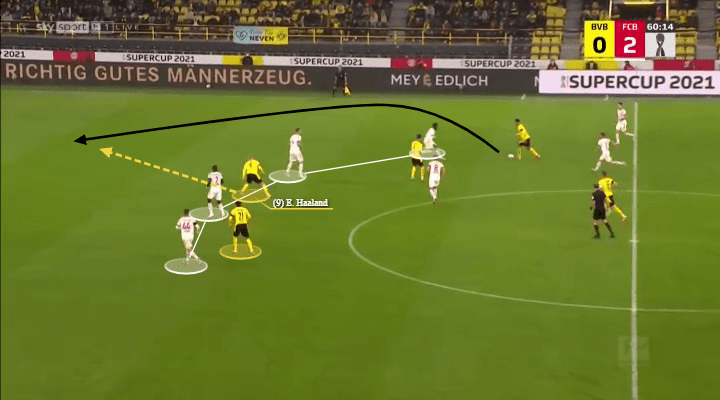
And again, here was why the Bayern backline could not push higher to squeeze spaces behind the midfield. Dortmund’s strikers were constantly staying high and being ready to attack the channel. Most oppositions were highly aware of Håland’s pace, which Rose could counteract and use Håland to absorb pressure.
Since the ball reaches Bellingham, Bayern’s left-back was forced to step up. But now, the centre-backs split and Håland could use his pace to attack the gap.
Variations and dynamism against Hoffenheim
In the game against Hoffenheim before the international break, it was Dortmund’s fourth time to use the diamond already. The team were more competent and fresher, hence, we discovered more variations of the attack.
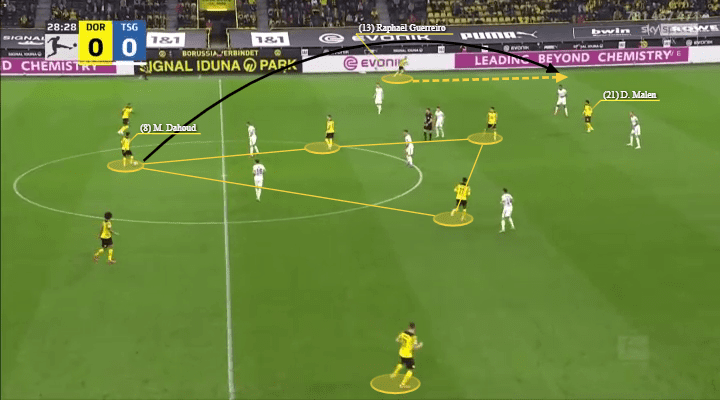
In the second phase against Hoffenheim, we more often saw Dahoud dropping between the centre-back to form a back three. This gave the wide centre-backs more spaces to carry the ball forward with the 3v2 in the first line. Also, operating outside of the formation allowed Dahoud to have more spaces to pass, with his face to the opposition goal.
The above example shows Dortmund’s improvements in the attack. Malen’s positioning was superb as he was right between the centre-back and right-back, pinning both into the centre. As a result, the wide channel was opened for Raphaël Guerreiro to exploit, and Dahoud could pick him with a long diagonal pass.
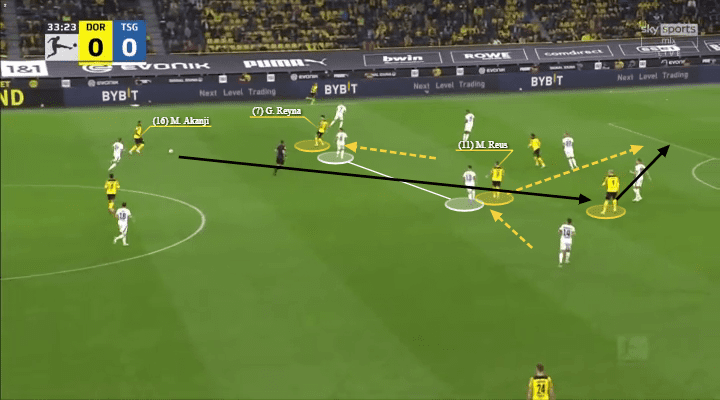
We also saw Dortmund using more off-ball runs to manipulate the markers. In this attack, they had Akanji carrying the ball forward again, and Reyna moved from the centre to offer a short option. Then, Reus moved to the left to fill the vacancy of Reyna. You could see the defensive midfielders of Hoffenheim’s 4-2-3-1 was moved and split because of the positional interchanges.
But then, the real intention of Akanji was to find Håland. The passing lane was opened after the movements that brought midfielders away. From here, Dortmund could easily use the third-man play to release Reus behind.
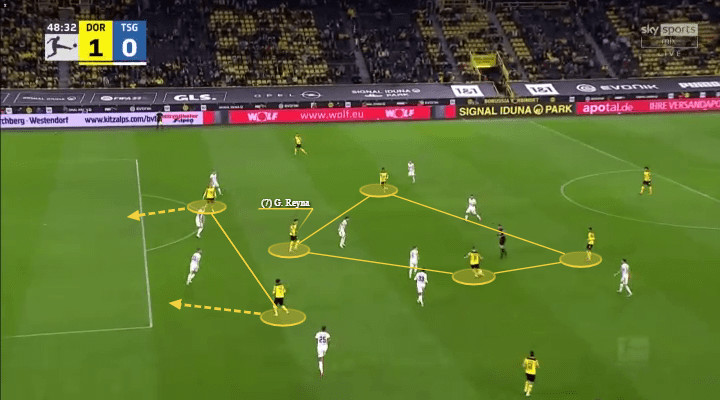
Reyna’s long-shot goal was a great shooting technique, but it was also down to the use of diamond. The above image was the scenario before Reyna receiving the ball. Dortmund strikers once again operating perfectly to create spaces behind the midfield. Both Håland and Malen were occupying the outside channel of the centre-backs, so the Black and Yellow very easily pushed four defenders away by two players.
And, since the wider midfielders of the diamond were a bit deeper, dragging the Hoffenheim defensive midfielders high, Reyna could have the spaces behind them.
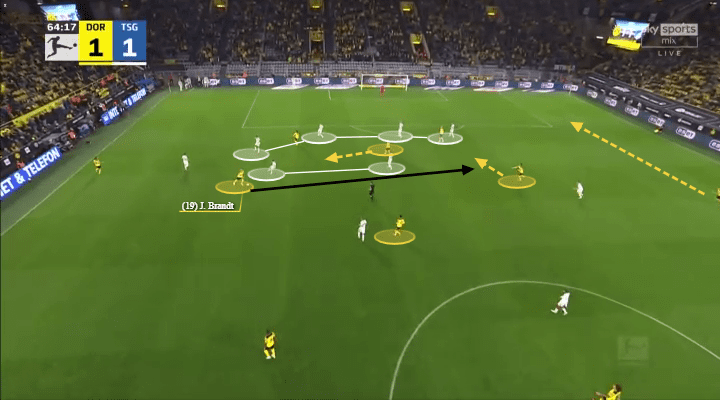
After the introduction of Julian Brandt, the attack of Dortmund carried more diagonality in the offensive third. In the last example of the section, the height of the diamond moved outward again, which drew the defensive midfielder to one flank. Simultaneously, the wide midfielder on the other side pushed forward to receive in the opposite half-spaces. The Hoffenheim left-back could not press as Håland was occupying him.
Also, on the right flank, Thomas Meunier was going forward to offer a switch option if they needed width in the final third.
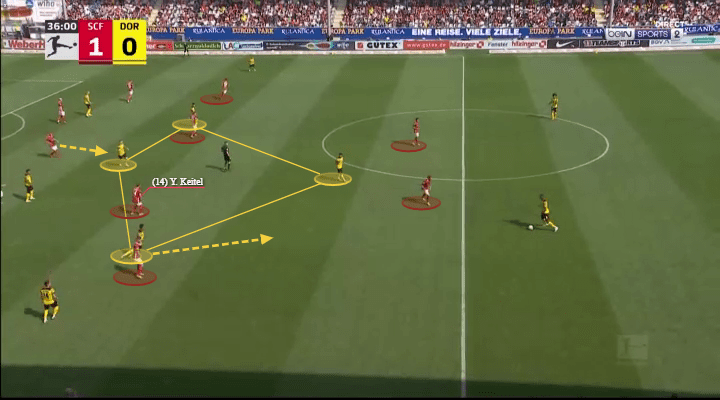
This was an example from their loss to Freiberg, they used similar concepts and the overload of diamond to play vertically. That line-breaking mindset was the philosophy of Rose’s football. With the diamond, Dortmund constantly dominated the central three zones, and that was very likely to stretch the midfielders of 4-4-2/4-2-3-1.
At here, when Reus dropped from a higher position, he caught the attention of Yannik Keitel, while Schulz fixed the right-winger as he occupied deeper wide spaces. Then, Dortmund easily freed the wide midfielder to receive in the half-spaces as no one was paying attention to him. The striker could not shut the passing lane as he was shadowing Dahoud in the process.
Areas to improve
As the results told, Dortmund did not win all the games even switching to a 4-diamond-2. The loss against Freiburg was a bit of surprise, as the Black and Yellow possessed better quality on paper. That game also hinted at some issues of Rose’s diamond which the team needed to be more careful in the future.
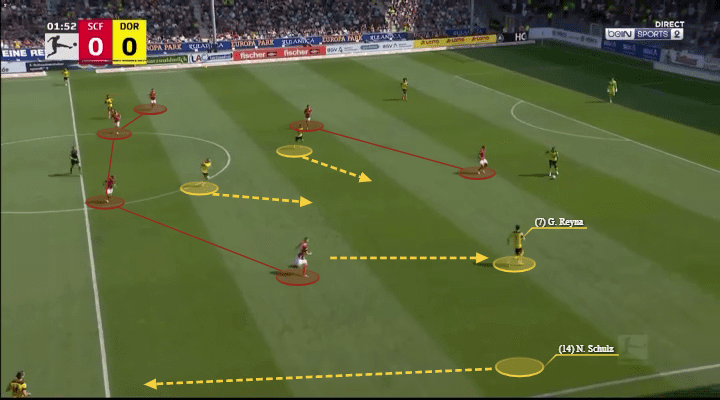
In that game, Freiburg defended in a 4-4-2 midblock, and a complete backline as the full-backs stayed in position more often. The strategy of Dortmund was to use the wide midfielder and full-back to create a 2v1 on the wingers. As indicated in the above image, when Schulz dashed forward, he bought time for Reyna to receive in the half-spaces.
But the next action of Dortmund’s moves was not good as both Dahoud and Reus supported in the same zone simultaneously. That killed spaces and the team lost the occupation of spaces behind the midfield, they could not move the ball forward. Dahoud, as the holding midfielder, must be stronger in communication with teammates.
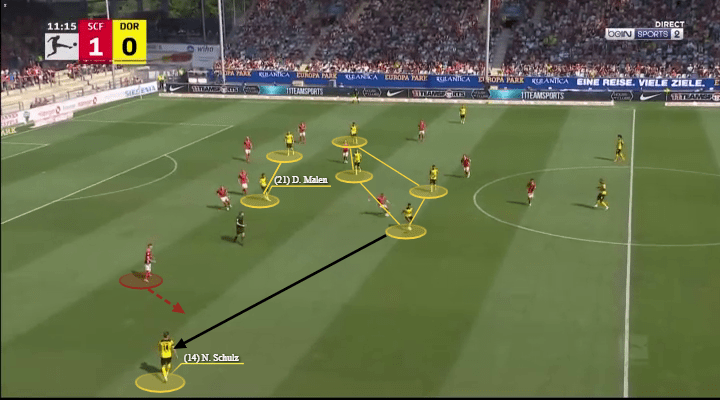
Another issue was more about the details and the structural issue of a 4-diamond-2. Firstly, if the left midfielder turned to the wrong side (left flank), he would be out of option as the team was lacking left-footed players. The above image was one of these situations.
Usually, he would only have the full-back as an option, but if the full-back was staying instead of going behind, the pass invited the press on backfoot. Dortmund were prone to lose the ball when Schulz was under pressure there.
Therefore, to maximize the power of the diamond, Dortmund’s left midfielder must be alerted to receive with his face to the right/centre, and on a half-turn. Or else, he could be easily pushed to the sideline, and the attack was trapped.
But the major reason for Dortmund’s loss was not the formation, Rose also stated there were positives to take, while the result was more because of the sloppy tempo and lacking the finishing in front of goal.
Conclusion
From the analysis, we pointed out the 4-diamond-2 favoured the characteristics of the players. The main reason for reverting the shape was the players were different from Gladbach’s, so Rose was willing to try again. Furthermore, it also seemed they wanted to opt for more control in a game, instead of crazily pressing around and playing in an extremely risky manner.
Nevertheless, Rose would not stick to the diamond forever. He is flexible, and when the team encountering more challenges in this season, we would see more shapes from his side to adapt to the opposition.





Comments